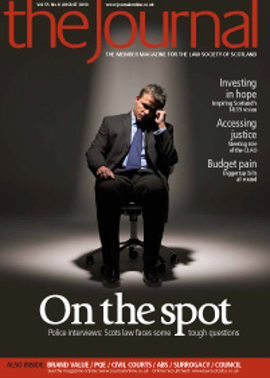What's in a name?

A new international brand valuation standard, ISO Standard 10668 (basic requirements for methods of monetary brand valuation) is due for publication in September 2010.
Its arrival seeks to settle decades of conjecture for those in the fields of marketing and finance. Yet its application may have greater implications for the legal profession.
A quick refresher
A brand is the identity of a specific product, service, or business. Valuation methodology requires the application of unequivocal interrelated inputs through specific modelling techniques. Brand valuation has thus been long criticised for lack of certainty in stating (or due to its subjective nature, the lack of belief that it is possible to state) the value of a brand with any agreeable precision. Hence the cliché when faced with brand value issues: how long is a piece of string?
Since the turn of the millennium there has been a remarkable rise in the number of brand valuation proponents who have felt the swell of the incoming valuation tide and anticipated business to be had in this field. Without universally accepted principles to guide, service has generally turned on cunning solutions which may provide an immediate client fix but are not a conclusive answer to the overarching problem. Their answer to the cliché would be: a piece of string is twice the distance from the middle to the end.
The tittle tattle over whether one can (and should) accurately appraise the monetary value of intangibles reached fever pitch last July when, unsatisfied with temporary and prevalent ad hoc remedies, the Patent Valuation Committee of the British Standards Institute was asked to consider a draft of the ISO Standard which would regulate matters. Feedback on the draft was possible until the end of September 2009. The final ISO Standard is now being prepared for publication.
Introducing method
If the published ISO Standard mirrors the draft (which the BSI through the UK Intellectual Property Office encouraged practitioners to comment on), then the arrival of ISO Standard 10668 may be applauded in a number of respects. First, it will outline three definitive methods for the valuation of brands. Secondly, it will introduce a valuation role for accountancy, legal and business analyst professionals. Thirdly, it will provide a timely solution to problems hitherto unforeseen by current legislation.
The ISO Standard will restrict brand valuation methodology to three possible options:
(1) The market approach – which measures brand value by reference to what other purchasers in the market have paid for similar assets.
(2) The cost approach – which measures brand value by reference to the cost invested in creating, replacing or reproducing the brand.
(3) The income approach – which measures brand value by reference to the economic benefits expected to be received over the remaining useful economic life of the brand. This involves estimating the expected future, after-tax cash flows attributable to the brand, then discounting them to a present value using an appropriate discount rate.
The ISO Standard also outlines acceptable methodology under the income approach, but such is outside the scope of this article.
Essential input
For those still awake, this is the part to note: the ISO Standard will stipulate the need for legal input as part of the valuation process. No brand valuation will be compliant without such input. Cha-ching!
Legal input includes an assessment of the legal protection afforded to the brand. Legal protection is to be appraised by identifying: (1) each of the legal rights that protect the brand; (2) the legal owner of each of those legal rights; and (3) the legal parameters influencing the value of the brand negatively or positively. Consideration should be given to any difference in legal protection afforded to the brand in each relevant jurisdiction.
The legal rights to be valued are to be determined by reference to: (1) the owner; (2) relevant national and regional laws; (3) rights acquired through registration; and (4) rights (or potential rights) acquired through use.
According to the ISO Standard’s notes, legal protection is one factor that informs brand value because it permits the brand owner to utilise formal legal systems to exclude third parties from using the same brand, thereby providing a degree of exclusivity.
It is not clear how an appraiser will be able to discharge their duties here without recourse to legal counsel. So advisers take note.
Ancillary lawyer roles
In addition to the new flush of advisory work that the ISO Standard will bring for intellectual property lawyers involved in analysing the legal rights and aspects of valuation, the ISO Standard may throw up at least three other types of work for lawyers.
Negotiation work: as grateful as brand owners will be for the ISO Standard’s three clear methods of brand valuation, there are still three methods. The choice of valuation method will be of major importance in terms of the derived monetary figure and will constitute a major negotiation tool in corporate deals.
Compliance work: the elephant in the room is compliance with the ISO Standard itself. In order for an appraisal to be ISO compliant, the appraiser must presumably fulfil their obligations contained in the ISO Standard, of which (according to the draft) there are about 17.
The obligations which have specific legal aspects include:
- Ascertaining that comparison is made only with brands that have similar characteristics, such as brand strength, goods and services, or economic and legal situation (draft ISO, para 5.3.2).
- Assessing the legal protection afforded to the brand, by identifying each of the legal rights that are a protected brand, the legal owner of each of those legal rights, and the legal parameters influencing the brand negatively or positively (draft ISO, para 6.3.1).
- Identifying the owner(s) and the legal rights related to the brand (draft ISO, para 6.3.2.1).
- Identifying the rights acquired through use, taking into account the territory of use and the market recognition according to respective national and regional law, in addition to requirements of para 6.3.2.2 (draft ISO, para 6.3.2.3).
- Taking into account the following parameters affecting the value of the brand positively and negatively: distinctiveness, scope of use/scope of registration (territory), goods and services, extent of use, notoriety/extent to which brand is well known, risk of cancellation, priority, dilution, and the ability and/or willingness of the owner to enforce legal rights (draft ISO, para 6.3.3).
The draft ISO also contains a general service level obligation that the appraiser shall use care and professional judgment to maintain independence and objectivity in reaching the valuation opinion (draft ISO, para 8).
Audit work: depending on the use of the final monetary valuation (e.g. as the basis of a security or as a yardstick for an acquisition), appraisals will without doubt generate the need for second opinion due diligence and audit work.
Plugging gaps
It has been demonstrated that the ISO Standard is not a placebo to quell an excited industry. The draft provides a clear framework in order to achieve an accurate brand valuation. By extension, the same framework could be used to value other intellectual property and intangible assets.
The application of the ISO Standard ought to be of wider interest in that it provides a timely solution to problems hitherto unforeseen by current legislation. An example might be the seeking of a residual attachment order under the Bankruptcy and Diligence etc (Scotland) Act 2007. There, the brand valuation criteria could assist a court in understanding the value of the brand(s) that are to be attached, and set out the valuation method and value for eventual sale of the brand(s). Otherwise the petitioner would be back to contemplating the length of string.
It is expected that the arrival of ISO Standard 10668 will deliver a hat trick. It will settle the debate over valuation techniques. It will add advisory, negotiation, compliance and audit services to the legal basket of low-hanging fruit. And it will resolve market failures of recent legislation.
- Philip A Hannay is an associate director at Macdonald Henderson. The views expressed are those of the author.
In this issue
- From Cadder to Calman via Constitution
- We can make the bill work
- The Cadder effect
- Bio Quarter: a case study
- Budgets of many colours
- Been there, done that
- Gill and the consumer
- Smoothing the path
- Net yourself a baby
- What's in a name?
- Inspiring change
- Further work in hand on constitution
- Faculty support on the agenda
- PCC's first year of "unsatisfactory" complaints
- From the Brussels office
- Learning in context
- Paper, pixel and process
- Growing cloud
- Ask Ash
- PQE: Post Qualification Equality?
- Technology to the rescue?
- "Definitive" approach
- Threat, or opportunity?
- Equality for all?
- Time to take a stand?
- A burden discharged
- The promise of certainty?
- A future for crofting
- Final tally
- Website review
- Book reviews
- An easy way to give?
- Three cheers for iPad






